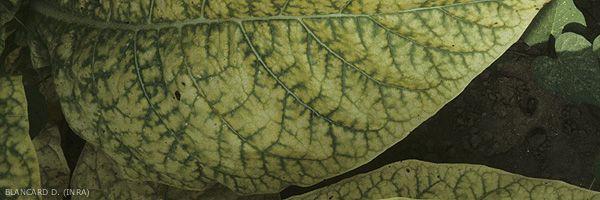
Nutritional deficiencies
Like many crops, tobacco needs various minerals for growth and good leaf quality. Its fertilisation is quite complex because it is particularly affected by:
- the richness and balance of soil nutrients (soil tests are essential);
- type of tobacco grown and the variety chosen;
- the use or not of supplementary irrigation and the resulting leaching;
- planting density;
- any other factor interfering with plant growth.
Given this situation, it is not uncommon to encounter field plants with deficient or excessive fertilisation. These disorders are called non-parasitic diseases that we have grouped under the heading of Nutritional problems. Their symptoms are quite frequently yellowing of different degrees on different plant areas (figures 1 and 2). The following two themes describe the main deficiencies encountered, their symptoms and disrupted physiological functions in tobacco. When speaking about deficiencies, we tend to associate real deficiencies with induced deficiencies.
Real deficiencies (i.e. a deficiency of nutrients in the soil) are increasingly rare, their diagnosis is very difficult de visu because, the symptoms they normally cause are discoloration and more or less intense yellowing of the leaves, which are very difficult to assess by a non-specialist.
In most cases we are dealing with induced deficiencies (nutrient elements are present but unavailable), which complicates diagnosis. In addition to determining the nature of the deficiency, we also have to find out the causes. They can be various, such as poorly managed irrigation (too much or not enough water), too low or too high temperature or soil pH, poor root systems, etc.
When you are faced with these kind of symptoms, you should take your time before drawing a conclusion of deficiency. Ask help from a technician and consult a specialist and carry out the necessary physical and chemical analyses of soil and vegetation.
♦ Deficiencies occur especially in crops fertilised empirically, in the absence of soil analysis.
Some deficiencies cause symptoms occurring first on lower leaves of the plant, and then gradually spreading all over the foliage. In this case, two main symptoms are observed:
♦ a diffuse mottling or chlorosis rather localised on the lower leaves, with or without necrotic spots and / or slight drying out;
Incriminated deficiencies
- Lack of potassium (K): chlorosis (often referred to as “firing”) is more or less marked at the leaf tips and sometimes at margins, accompanied by necrotic spots. The lower leaves are curved towards the underside of lamina surface (figures 3 and 7). The major physiological functions disrupted by lack of K are the osmotic regulation of the plant and the ionic balance of cells (pH) and therefore the opening of stomata, activation of many enzymes, and decrease in layer thickness as well as disease and stress resistance;
- Magnesium (Mg) deficiency: interveinal chlorosis begins along the margins of the lamina and may result in leaf whitening (chlorosis), while the veins tend to retain their green colour. There are no necrotic spots (figures 8 to 11). Magnesium is a major component of chlorophyll and also a co-factor of many enzymes.
♦ a rather widespread yellowing throughout the plant, followed by drying up of lower leaves;
Incriminated deficiencies
- Nitrogen (N) deficiency: the leaves are pale green, older ones turn yellow and tend to become necrotic and dry up. The plants are less vigorous. Chlorophyll and protein synthesis are the most affected (nitrogen being in the composition of amino acids) but also nucleic acids, which greatly influence all metabolic functions;
- Phosphorus (P) deficiency: the leaves are dark green, the lower leaves turn yellow and dry up (figure 6). Some of them may be narrowed. Phosphorus is one of the energy carrier components which are essential to the metabolism of the plant, and to membrane phospholipids.
Symptoms appearing on younger leaves
Symptoms of several deficiencies appear more usually in the apex and younger leaves; when this happens one can observe:
♦ a deformation and a necrosis of the tip or base of young leaves with decay of terminal bud;
Incriminated deficiencies:
- Calcium (Ca) deficiency: the leaf apices are light green, dull, and tend to curve downward and become necrotic (figure 7). Calcium is a major constituent of the cell layer in the form of pectate and oxalate, it is involved in elongation and cell division, in the structural stability of tissues and in regulation of membrane exchanges;
- Boron deficiency (B): young leaves are distorted. The lamina at the leaf base turns light green and can break down later. The leaves show large deformations and the terminal bud may die or stop growing (figures 8 and 9). Boron is involved in calcium utilisation. This trace element is a co-factor in the synthesis of nucleic acids and it is involved in membrane integrity.
♦ chlorosis of young leaves of the apex with or without necrotic spots and vein colour changes, the terminal bud staying alive;
Incriminated deficiencies:
- Manganese (Mn) deficiency: the most characteristic symptoms are chlorosis of younger leaves with scattered necrotic spots, the veins remain green. Manganese is an activator of certain enzymes and is necessary for the integrity of the chloroplast membranes It is involved in the delivery of oxygen during photosynthesis;
- Sulfur (S) deficiency : younger leaves are pale green and their veins are about the same colour. The stem may be short and thin. Sulfur is included in the composition of components of two amino acids, which are essential constituents of proteins, it is also involved in coenzyme A, a major component of Krebs cycle;
- Iron (Fe) deficiency: this deficiency is shown by chlorosis of young leaves with main veins remaining green and contrasting with interveinal tissues. Subsequently, the entire lamina may discolor. Iron is essential in the synthesis of chlorophyll. It is a component of cytochrome electron carriers in the respiratory chain.





